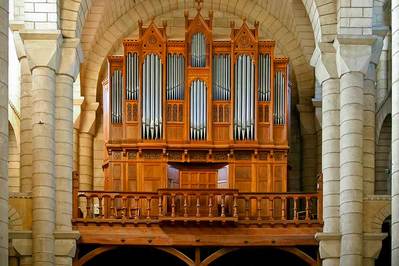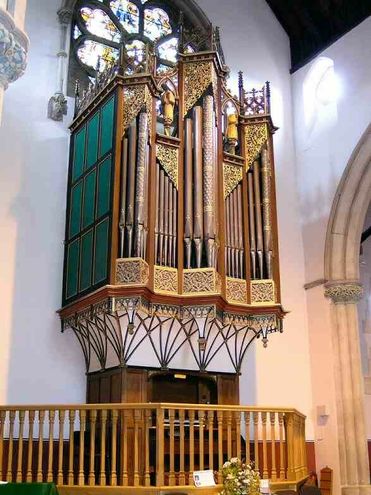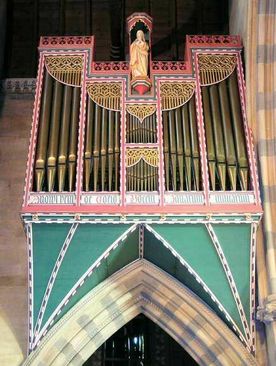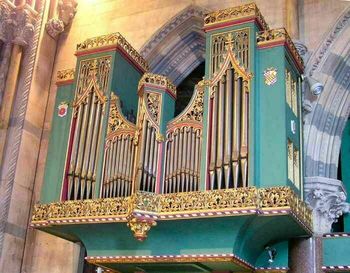Gothick Cases
David Bridgeman-Sutton continues probing into case designs of the Gothic Age
|
The rounded arches, domes, colonnades and pedimented windows and doors, familiar from St Peter's Rome, St Paul's Cathedral and Washington's White House, belong to a classical style of building that originated in Italy. Its use spread - slowly - to much of Europe, displacing patterns that had developed over half-a-milennium. By about 1500, Gothic was widely regarded in the way of many recently discarded fashions; at best it was seen as as quaint, often as ugly and sometimes as downright barbaric (or should that be barbarick?) Extensions and additions to older buildings were often in the "new" style, contrasting with the old - sometimes rather unhappily; Sir Christopher Wren's Library for Lincoln cathedral was better than some essays in this direction. A number of ancient churches were replaced and it is fair to assume that only the vast size and solidity of many mediaeval cathedrals saved them from the same fate. Organs and their cases are more readily altered or replaced; nearly all of those that had survived warfare and revolution succumbed to musical and architectural vogue.
|
Nothing goes and comes round more surely than fashion. By about 1750, interest in Gothick revived in England, the final "k" being a spelling quirk of the age. Horace Walpole (b.1717), a wealthy antiquarian and collector enlarged his house, Strawberry Hill, near London, filling it with fireplaces, furniture, fittings and even ceilings in his version of Gothic. James Wyatt (b.1746) was commissioned to design or restyle much domestic architecture in a similar manner. Their work, and that of others at the time, lacked the scale and solidity of the original and was often fanciful and inaccurate in detail. It served, however, to stimulate interest in this style first in Europe and, later, more widely. In many countries, up until about the end of the 19th century every kind of public building, from railway stations and schools to churches and town-halls, was "in Gothic style". Many architects developed great skill in adapting scholarly designs to uses undreamed of in the Middle Ages.
Organ builders followed fashion. Some decades would pass before scholarly works on mediaeval cases would become available, so considerable imagination was used to produce examples that looked unquestionably Gothic. There were numerous features and fancies from which to choose - spires, gables, crockets, the whole gallimaufry - and designers did not stint themselves. Three remarkable cases illustrating this come from the first half of the nineteenth century. Lincoln cathedral (1826); York Minster (1832 - picture 1) and St Denys, Paris (c. 1835)
Organ builders followed fashion. Some decades would pass before scholarly works on mediaeval cases would become available, so considerable imagination was used to produce examples that looked unquestionably Gothic. There were numerous features and fancies from which to choose - spires, gables, crockets, the whole gallimaufry - and designers did not stint themselves. Three remarkable cases illustrating this come from the first half of the nineteenth century. Lincoln cathedral (1826); York Minster (1832 - picture 1) and St Denys, Paris (c. 1835)
|
As the century progressed, cases tended to become simpler, at least in England where neo-gothic often gave way to the piperack.
France has always taken these things more seriously: there much trouble was taken with even relatively plain cases as at St Hilaire, Poitiers (pic 2) |
|
The work of Arthur Hill and Sir John Sutton, mentioned on the previous page, gave builders new insights into what Gothic cases had really been like. George Frederick Bodley was, perhaps, the most influential British church architect of the 19th century: his work included the cathedrals of Washington DC and Hobart, Tasmania. He paid meticulous attention to detail and designed a number of organ-cases of great distinction.
A copy of one is found at the church of the Immaculate Conception, Stroud, England (pic 3). The influence of Kiedrich here is evident, though features from other instruments have been added. Note the embossing of the central pipes in the three towers, the elegant fretting and the coving that imitates stone vaulting. In all a splendid, free-standing case for a small organ. |
|
In 1887, All Saints' church, Cheltenham, had a fine 4-manual built by William Hill; (the influence behind this seems to have been the organist of the time, Adolph Holst whose son, Gustav, composed The Planets Suite and pieces for string orchestra). The instrument stands in a chamber on the North East side, speaking into both Nave and Chancel.
At the time of building, Arthur Hill designed, for the Nave opening, a colourful and scholarly case surmounted by a figure of St Celia (pic 4). Twenty years later H A Prothero, who had clearly studied Hill's work, designed a second case for the Chancel opening (pic 5). The two make perfect companions, though careful observation shows a number of differences in detail. A happy touch on the Chancel case is the introduction of two shields-of-arms, which reflect the mediaeval roots of the overall design. |
|
FOOTNOTE: "The Stroud organ has links with a composer even more famous than Holst. It was built for St Rose's Convent, Stroud, where Edward Elgar's sister, Eileen Agnes - known as Dot - was a nun. She later became Mother General of the Dominican order in England. Elgar certainly played this instrument, which, according to some accounts, was his gift to the community. The organ was transferred to its present location when the convent closed in 1980". Thanks to Philip Wells for this information.
David Bridgeman-Sutton, September, 2010 |
David Bridgeman-Sutton, September,2010
Picture credits:
1 Dr Thorsten Hauler
2 Jenny Setchell
3 , 4 and 5 Philip Wells.
1 Dr Thorsten Hauler
2 Jenny Setchell
3 , 4 and 5 Philip Wells.






